Capital One 2012 Annual Report Download - page 273
Download and view the complete annual report
Please find page 273 of the 2012 Capital One annual report below. You can navigate through the pages in the report by either clicking on the pages listed below, or by using the keyword search tool below to find specific information within the annual report.-
 1
1 -
 2
2 -
 3
3 -
 4
4 -
 5
5 -
 6
6 -
 7
7 -
 8
8 -
 9
9 -
 10
10 -
 11
11 -
 12
12 -
 13
13 -
 14
14 -
 15
15 -
 16
16 -
 17
17 -
 18
18 -
 19
19 -
 20
20 -
 21
21 -
 22
22 -
 23
23 -
 24
24 -
 25
25 -
 26
26 -
 27
27 -
 28
28 -
 29
29 -
 30
30 -
 31
31 -
 32
32 -
 33
33 -
 34
34 -
 35
35 -
 36
36 -
 37
37 -
 38
38 -
 39
39 -
 40
40 -
 41
41 -
 42
42 -
 43
43 -
 44
44 -
 45
45 -
 46
46 -
 47
47 -
 48
48 -
 49
49 -
 50
50 -
 51
51 -
 52
52 -
 53
53 -
 54
54 -
 55
55 -
 56
56 -
 57
57 -
 58
58 -
 59
59 -
 60
60 -
 61
61 -
 62
62 -
 63
63 -
 64
64 -
 65
65 -
 66
66 -
 67
67 -
 68
68 -
 69
69 -
 70
70 -
 71
71 -
 72
72 -
 73
73 -
 74
74 -
 75
75 -
 76
76 -
 77
77 -
 78
78 -
 79
79 -
 80
80 -
 81
81 -
 82
82 -
 83
83 -
 84
84 -
 85
85 -
 86
86 -
 87
87 -
 88
88 -
 89
89 -
 90
90 -
 91
91 -
 92
92 -
 93
93 -
 94
94 -
 95
95 -
 96
96 -
 97
97 -
 98
98 -
 99
99 -
 100
100 -
 101
101 -
 102
102 -
 103
103 -
 104
104 -
 105
105 -
 106
106 -
 107
107 -
 108
108 -
 109
109 -
 110
110 -
 111
111 -
 112
112 -
 113
113 -
 114
114 -
 115
115 -
 116
116 -
 117
117 -
 118
118 -
 119
119 -
 120
120 -
 121
121 -
 122
122 -
 123
123 -
 124
124 -
 125
125 -
 126
126 -
 127
127 -
 128
128 -
 129
129 -
 130
130 -
 131
131 -
 132
132 -
 133
133 -
 134
134 -
 135
135 -
 136
136 -
 137
137 -
 138
138 -
 139
139 -
 140
140 -
 141
141 -
 142
142 -
 143
143 -
 144
144 -
 145
145 -
 146
146 -
 147
147 -
 148
148 -
 149
149 -
 150
150 -
 151
151 -
 152
152 -
 153
153 -
 154
154 -
 155
155 -
 156
156 -
 157
157 -
 158
158 -
 159
159 -
 160
160 -
 161
161 -
 162
162 -
 163
163 -
 164
164 -
 165
165 -
 166
166 -
 167
167 -
 168
168 -
 169
169 -
 170
170 -
 171
171 -
 172
172 -
 173
173 -
 174
174 -
 175
175 -
 176
176 -
 177
177 -
 178
178 -
 179
179 -
 180
180 -
 181
181 -
 182
182 -
 183
183 -
 184
184 -
 185
185 -
 186
186 -
 187
187 -
 188
188 -
 189
189 -
 190
190 -
 191
191 -
 192
192 -
 193
193 -
 194
194 -
 195
195 -
 196
196 -
 197
197 -
 198
198 -
 199
199 -
 200
200 -
 201
201 -
 202
202 -
 203
203 -
 204
204 -
 205
205 -
 206
206 -
 207
207 -
 208
208 -
 209
209 -
 210
210 -
 211
211 -
 212
212 -
 213
213 -
 214
214 -
 215
215 -
 216
216 -
 217
217 -
 218
218 -
 219
219 -
 220
220 -
 221
221 -
 222
222 -
 223
223 -
 224
224 -
 225
225 -
 226
226 -
 227
227 -
 228
228 -
 229
229 -
 230
230 -
 231
231 -
 232
232 -
 233
233 -
 234
234 -
 235
235 -
 236
236 -
 237
237 -
 238
238 -
 239
239 -
 240
240 -
 241
241 -
 242
242 -
 243
243 -
 244
244 -
 245
245 -
 246
246 -
 247
247 -
 248
248 -
 249
249 -
 250
250 -
 251
251 -
 252
252 -
 253
253 -
 254
254 -
 255
255 -
 256
256 -
 257
257 -
 258
258 -
 259
259 -
 260
260 -
 261
261 -
 262
262 -
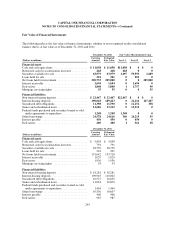 263
263 -
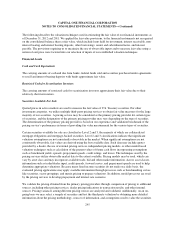 264
264 -
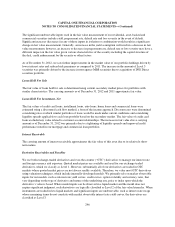 265
265 -
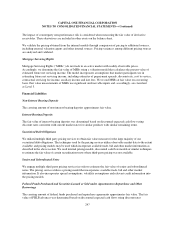 266
266 -
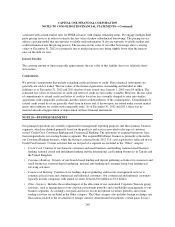 267
267 -
 268
268 -
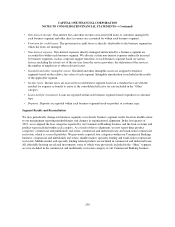 269
269 -
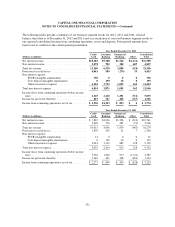 270
270 -
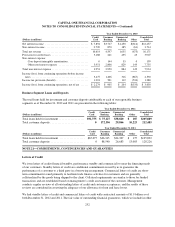 271
271 -
 272
272 -
 273
273 -
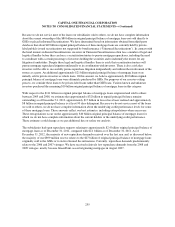 274
274 -
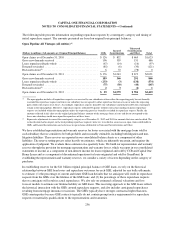 275
275 -
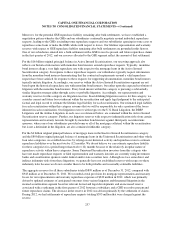 276
276 -
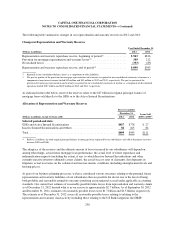 277
277 -
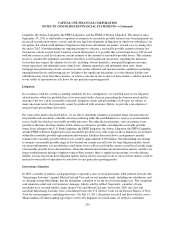 278
278 -
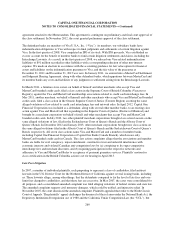 279
279 -
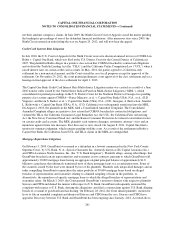 280
280 -
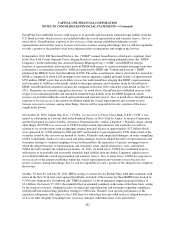 281
281 -
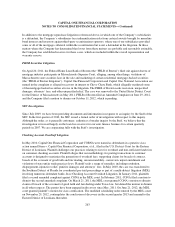 282
282 -
 283
283 -
 284
284 -
 285
285 -
 286
286 -
 287
287 -
 288
288 -
 289
289 -
 290
290 -
 291
291 -
 292
292 -
 293
293 -
 294
294 -
 295
295 -
 296
296 -
 297
297 -
 298
298 -
 299
299 -
 300
300 -
 301
301 -
 302
302 -
 303
303 -
 304
304 -
 305
305 -
 306
306 -
 307
307 -
 308
308 -
 309
309 -
 310
310 -
 311
311
 |
 |

CAPITAL ONE FINANCIAL CORPORATION
NOTES TO CONSOLIDATED FINANCIAL STATEMENTS—(Continued)
of the mortgage loans, but mortgage loan performance often influences whether a claim for breach of
representation and warranty will be asserted and has an effect on the amount of any loss in the event of a breach
of a representation or warranty.
Each of these subsidiaries may be required to repurchase mortgage loans in the event of certain breaches of these
representations and warranties. In the event of a repurchase, the subsidiary is typically required to pay the then
unpaid principal balance of the loan together with interest and certain expenses (including, in certain cases, legal
costs incurred by the purchaser and/or others). The subsidiary then recovers the loan or, if the loan has been
foreclosed, the underlying collateral. The subsidiary is exposed to any losses on the repurchased loans after
giving effect to any recoveries on the collateral. In some instances, rather than repurchase the loans, a subsidiary
may agree to make a cash payment to make an investor whole on losses or to settle repurchase claims. In
addition, our subsidiaries may be required to indemnify certain purchasers and others against losses they incur as
a result of certain breaches of representations and warranties. In some cases, the amount of such losses could
exceed the repurchase amount of the related loans.
These subsidiaries, in total, originated and sold to non-affiliates approximately $111 billion original principal
balance of mortgage loans between 2005 and 2008, which are the years (or “vintages”) with respect to which our
subsidiaries have received the vast majority of the repurchase requests and other related claims.
The following table presents the original principal balance of mortgage loan originations, by vintage for 2005
through 2008, for the three general categories of purchasers of mortgage loans and the outstanding principal
balance as of December 31, 2012 and 2011:
Unpaid Principal Balance of Mortgage Loans Originated and Sold to Third Parties Based on Category of
Purchaser
Unpaid Principal Balance
December 31, Original Unpaid Principal Balance
(Dollars in billions) 2012 2011 Total 2008 2007 2006 2005
Government sponsored enterprises (“GSEs”)(1) ...... $4 $5 $11 $1 $4 $3 $3
Insured Securitizations ......................... 56 20 0 2 8 10
Uninsured Securitizations and Other .............. 23 30 80 3 15 30 32
Total ....................................... $32 $41 $111 $4 $21 $41 $45
(1) GSEs include Fannie Mae and Freddie Mac.
Between 2005 and 2008, our subsidiaries sold an aggregate amount of $11 billion in original principal balance
mortgage loans to the GSEs.
Of the $20 billion in original principal balance of mortgage loans sold directly by our subsidiaries to private-label
purchasers who placed the loans into securitizations supported by bond insurance (“Insured Securitizations”),
approximately $16 billion original principal balance was placed in securitizations as to which the monoline bond
insurers have made repurchase requests or loan file requests to one of our subsidiaries (“Active Insured
Securitizations”), and the remaining approximately $4 billion original principal balance was placed in securitizations as
to which the monoline bond insurers have not made repurchase requests or loan file requests to one of our subsidiaries
(“Inactive Insured Securitizations”). Insured Securitizations often allow the monoline bond insurer to act independently
of the investors. Bond insurers typically have indemnity agreements directly with both the mortgage originators and the
securitizers, and they often have super-majority rights within the trust documentation that allow them to direct trustees
to pursue mortgage repurchase requests without coordination with other investors.
254
